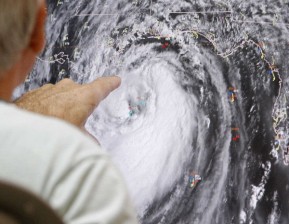Uneasy New Orleans braces for Hurricane Isaac

Senior hurricane specialist Stacy Stewart tracks Isaac at the National Hurricane Center in Miami, Tuesday, Aug. 28, 2012. Forecasters at the National Hurricane Center warned that Isaac, especially if it strikes at high tide, could cause storm surges of up to 12 feet (3.6 meters) along the coasts of southeast Louisiana and Mississippi and up to 6 feet (1.8 meters) as far away as the Florida Panhandle. (AP Photo/Alan Diaz)
NEW ORLEANS—Isaac was upgraded Tuesday to hurricane status as New Orleans girded for the impact seven years after Hurricane Katrina devastated the “Big Easy” and killed 1,800 people across the US Gulf Coast.
The National Hurricane Center in Miami said an Air Force aircraft reported the storm’s maximum winds had increased to 75 mph (120 km/hour), just above the threshold for an upgrade to a category one hurricane.
The storm was expected to make landfall later in the day.
US President Barack Obama urged people take the threat seriously, warning of the possibility of major flooding and damage.
“I want to encourage all residents of the Gulf Coast to listen to your local officials and follow their directions, including if they tell you to evacuate,” Obama said in a televised statement at the White House.
Article continues after this advertisement“Now is not the time to tempt fate. Now is not the time to dismiss official warnings. You need to take this seriously,” Obama said.
Article continues after this advertisementObama said he had managed a wide-ranging effort by federal and local governments to make preparations.
His appearance was a reminder of the power of an incumbent president to intervene at politically advantageous moments, as he sought to project an image of strength and competence, just as Republicans met for their National Convention to nominate Mitt Romney as their candidate for the November presidential election.
The US National Hurricane Center said in an earlier advisory that in some Gulf Coast areas — such as the Mississippi-Alabama border east to Florida — a hurricane warning has been replaced with a tropical storm warning.
But a full-blown hurricane warning remained in effect for metropolitan New Orleans, a city known as the Big Easy for its jazz and easy-going life-style.
The streets of New Orleans were eerily empty Monday as smatterings of rain and stiff winds forewarned Isaac’s arrival.
Most residents had already boarded up their windows and stocked up on essentials as they prepared to either evacuate or hunker down.
But weak though Isaac was forecast to be, the timing of the storm — set to arrive on the seventh anniversary of Katrina — had many here on edge.
“It brings back a whole lot of memories,” said Melody Barkum, 56, who spent days stranded on a roof without food or water after Katrina struck.
“I’m not afraid,” Barkum told AFP. “If I can survive Katrina, I can survive this.”
Katrina left behind a devastating sprawl of destruction and death when it hit New Orleans on August 29, 2005, and a bungled response by the Bush administration was a black mark on his second term in office.
Thousands of people were left stranded on the roofs of their houses for days after Katrina’s powerful storm surge smashed levees long-warned to be inadequate, flooding 80 percent of the low-lying city.
Those who managed to make it to dry land faced deadly violence and looting as the city descended into chaos and officials failed to even provide water and food — let alone security and medical aid — to those suffering in the sweltering heat.
Officials insisted that the billions of dollars spent to reinforce the city’s storm levees and pumps will protect the Big Easy from inundation, and Isaac is nowhere near Katrina’s strength.
But Isaac will still pack powerful winds expected to knock out power lines and churn up a massive surge of sea water as much as 12 feet (3.7 meters) deep that will roll up across the Gulf Coast.
Mandatory evacuations have been ordered in a number of coastal counties in Louisiana and Alabama, where people typically build their homes on stilts.
The slow-moving and massive storm — which is about 410 miles (670 kilometers) wide — could dump as much as 20 inches (51 centimeters) of rain and spawn tornadoes, the NHC warned.
Obama, no doubt mindful of the bungled handling of Katrina by his predecessor George W. Bush, on Monday declared a state of emergency in Louisiana, allowing federal funds and aid to flow to local authorities.
The US Nuclear Regulatory Commission sent extra staff to two nuclear power plants in Louisiana. They are about 20 and 25 miles from New Orleans and Baton Rouge, respectively.
Louisiana Governor Bobby Jindal, who has recommended voluntary evacuations, urged people to prepare for the worst.
“If you are in low-lying areas and are thinking about evacuating, today is the day to do that,” he said Monday.
“If you plan on hunkering down at home, today is the day to get supplies. I strongly encourage people not to wait,” added Jindal, who stayed away from the weather-delayed Republican National Convention in Tampa, Florida.
Those heeding the call included Tammy Edmondson, who looked anxious as she picked through the grocery shelves at a Target store with her daughter.
Edmondson said she left town ahead of Katrina and that it was a month before she could go home.
“We had a lot of damage — we’re still fixing some of it,” she told AFP. “That’s why I’m starting to panic.”